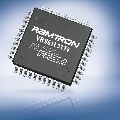基于纳米逻辑和新型存储器的“感存算一体”三维片上集成系统 | 本周物理学讲座
报告人:唐建石,清华大学
时间:6月12日(周三)14:30
单位:中科院物理研究所
地点:M楼249会议室
随着摩尔定律的放缓以及冯·诺依曼瓶颈的显现,未来亟需引入新材料与新计算架构来进一步提高芯片性能和能效比。本次报告将首先介绍基于碳纳米管(carbon nanotubes)的高性能逻辑电路技术和柔性电路与传感器,讨论其面临的主要技术挑战,并介绍我们在材料、器件、电路与集成等方向上的最新研究进展。在报告的后半部分,我们将讨论新型存储器在类脑计算领域的应用,并着重介绍基于离子嵌入的非挥发性电化学存储器(ECRAM)。与传统的RRAM、PCM等器件相比,ECRAM展现出高对称性、高线性度、低随机性的模拟阻变翻转特性,因此在高效能的类脑计算上具有很大的应用潜力。展望未来芯片的发展趋势,基于上述纳米逻辑电路、传感器和新型存储器,我们将介绍“感存算一体“的三维片上集成系统,通过高带宽的层间数据互连来实现跟高效的数据获取、计算和存储。
报告人:Degang Chen,Iowa State University
单位:中科院半导体研究所
时间:6月11日(周二)10:00
地点:2号楼303A会议室
3Measuring operator size growth in quantum quench experiments
报告人:Xiaoliang Qi,Stanford University
时间:6月11日(周二)16:00
单位:清华大学
地点:理科楼郑裕彤讲堂
Operator scrambling denotes the evolution of a simple operator into a complicated one (in the Heisenberg picture), which characterizes quantum chaos in many-body systems. More specifically, a simple operator evolves into a linear superposition of many operators, most of which are many-body operators supported on a region of size much larger than 1. In general, an operator does not have a definite size but is characterized by a probability distribution of size. The operator size is related to out-of-time-order correlation functions, but these are generically difficult to obtain from experimental observables. In this paper we show that the operator size distribution can be measured in quantum quench experiments. In a quantum spin system, we propose to prepare an ensemble of initial states which are direct product states of random pure states of each spin qudit, and measure a simple physical observable (such as a particular component of spin) at later time t. The initial state dependence of the expectation value measures a particular component of the operator size distribution. Furthermore, many other features of the operator size distribution can be measured by analyzing the same data, such as the support of the operator in space.
4GRAVITY science highlights and technical challenge/advance in near-infrared interferometry
报告人:Feng Gao,Max Planck Institute for extraterrestrial Physics
时间:6月12日(周三)12:00
单位:北京大学
地点:1st floor meeting room, KIAA
GRAVITY is a 2nd generation beam combiner instrument for the Very Large Telescope Interferometer at ESO's Paranal Observatory in Northern Chile. Commissioned in early 2017, it coherently combines beams from 4 telescopes at near-infrared K band (2 micron) to form a telescope with equivalent diameter of 130 meters and collecting area of up to 200m^2. In this talk, I will briefly introduce the GRAVITY working principles, then focusing on the science highlights achieved with GRAVITY observations on the Galactic Center, AGN and exo-planets in the past 2 years. For the rest of the talk, I will focusing on the technical challenges encountered in the GRAVITY project in the past and how they have been overcome/mitigated. I will end with future perspective for GRAVITY and also share the lessons I've learned in my transition from an outsider to an insider in the project.
报告人:Yefei Yuan,USTC
时间:6月13日(周四)14:00
单位:清华大学
地点:蒙民伟科技南楼S727
General relativity (GR) has passed every test in our solar system, to date. But there is still a lack of strict tests of GR in the strong gravitional field near the event horizon of black holes. Owling to their proximity, the event horizon of SgrA* and M87* (two massive black holes residing in the center of our Galaxy and the giant elliptical galaxy M87, respectively) have the largest angular sizes in the sky, they are the natural laboratories for studying physics of strong gravitional fields.
At 21:00 on April 10, 2019 (SGT), the first Event Horizon Telescope (EHT) image of M87* was released, which clearly shows the black hole shadow for the first time, and directly demonstrates the existence of black hole in our Universe. In addition, in May 2018, VLTI-Gravity of the European Southern Observatory detected the orbital motions of hot spots near the last stable circular orbit of the SgrA. In this talk, after a very brief introduction to the physics of strong graivtional fields, I will convince you how to use the gas dynamics and radiation around the horizon of SgrA* and M87* to test general relativity in the strong field regime.
报告人:刘亮,中国科学院上海光学精密机械研究所
时间:6月13日(周四)16:00
单位:清华大学
地点:理科楼郑裕彤讲堂
自空间冷原子钟随天宫二号于2016年9月15日发射以来在轨已经超过2年半,取得了一系列成果。作为天宫二号空间实验室的主要载荷之一,空间冷原子钟在轨进行了测试并成功地运行,使其成为世界上第一个在轨运行的冷原子钟。本报告将给出空间冷原子钟的背景和历史,简单介绍了原子钟的基本原理和应用,给出了部分在轨测试结果,并对结果的意义进行了讨论。报告还将讨论空间冷原子钟在卫星导航系统和基础物理研究中的应用。报告还将给出发射过程中的一些相关事项。
报告人:Kevin France,University of Colorado
时间:6月13日(周四)16:00
单位:北京大学
地点:KIAA-PKU Auditorium
High-energy photons and particles from stars regulate the atmospheric temperature structure and photochemistry on orbiting planets, influencing the long-term stability of planetary atmospheres and the production of potential “biomarker” gases. Rocky planets orbiting low-mass stars (M dwarfs) will likely be the first exoplanets directly probed for signs of life, however, relatively few observational and theoretical constraints exist on the high-energy irradiance from typical (i.e., weakly active) M dwarf exoplanet host stars. In this talk, I will describe results from an ongoing panchromatic survey (Chandra/XMM/Hubble/ground) of M and K dwarf exoplanet hosts. The MUSCLES* Treasury Survey combines UV, X-ray, and optical observations, reconstructed Lyman-alpha and EUV (10-90 nm) radiation, and next-generation stellar atmosphere models to provide realistic inputs for modeling the stability and climate on potentially habitable planets around red dwarfs. I will present an overview of the project and focus on three main results – 1) the evolution of the high-energy spectral energy distribution as a star’s habitable zone moves inward from 1 to 0.1 AU, including implications for the possible abiotic production of the suggested biomarkers O2 and O3, 2) new estimates of the high-energy particle fluxes (from CMEs/SEPs) from these stars based on solar UV flare/particle flux measurements, and 3) characterization of the high-energy variability on active and inactive M dwarfs, with an emphasis on the potential for these impulsive events to drive large-scale atmospheric mass loss. I will conclude by presenting a short summary of our prospects to complete the stellar census at EUV wavelengths and spectroscopically characterize the atmospheres of potentially inhabited planets around M dwarfs in the next ~20 years. * Measurements of the Ultraviolet Spectral Characteristics of Low-mass Exoplanetary Systems
报告人:Subhash Bose,KIAA
时间:6月14日(周五)12:00
单位:北京大学
地点:KIAA 1st meeting room
Massive stars end their life as energetic supernova (SN) explosions. They are produced from a wide range of progenitor and environments, and so their observed properties are also diverse. Despite several decades of studies of these objects, various aspects are still poorly understood and highly debated. With the emergence of several all-sky and untargeted surveys, we are now able to find several extreme and unusual SNe which were previously unknown and challenges our present understanding of these objects. It is important to examine the rare and peculiar behaviors of these SNe to find clues to the missing links in our present understanding. I will discuss a few interesting and rare SNe which we studied, namely Gaia17biu, ASASSN-16at, and ASASSN-15nx. Gaia17biu belongs to a very luminous and rare class of supernovae, known as Superluminous supernovae (SLSNe). The SN was discovered in a host galaxy which is very unusual for these type of objects. Interestingly Gaia17biu was also the closest SLSN-I when discovered. We observed this SN in unprecedented detail, which was not possible for any other SLSNe. Another object, ASASSN-16at was a normal hydrogen-rich supernova as evident from early time evolution. However, the late nebular phase spectra showed strong bifurcation in HI emissions lines, which is unprecedented for any SNe. Such a double-peaked profile of HI emission suggests strong bipolarity in inner ejecta. The third object, ASASSN-15nx, is a peculiar hydrogen-rich supernova, with luminosity in between core-collapse and superluminous SNe. Among a host of peculiar features, ASASSN-15nx showed a remarkable, almost perfect linear-declining light-curve until 270 days. Such an atypical light curve evolution contradicts our present understanding of CCSNe. Although the exact powering mechanism is still unclear, from our detailed study, we proposed some of the possible scenarios to explain the observed behaviors.
报告人:Hassen Yesuf,KIAA
时间:6月14日(周五)14:00
单位:清华大学
地点:蒙民伟科技南楼S727
I will present our work in which we use bulge-type classifications of representative galaxies from the Sloan Digital Sky Survey by Gadotti (2009) to classify galaxies into real bulges and pseudobulges using a machine learning algorithm. We use structural and stellar population predictors that can be measured easily without image decomposition into bulge, bar and disc as done in the training sample. We find that multiple parameters such as the central mass density within 1 kpc, the concentration index, and Sersic index result in accurate bulge classification when combined together. We classify about 45,000 massive galaxies (> 10^10 solar mass) below 0.07 redshift into real bulges or pseudobulges with 93% accuracy. We then show that about 75 - 90% of AGNs are hosted by galaxies with real bulges. The pseudobulge fraction significantly decreases with AGN line ratio signatures as the ratios change from indicating pure star formation (~55%), to composite of star formation and AGN (~20%), and to AGN-dominated galaxies (~5%). Using the dust-corrected [O III] luminosity as an AGN accretion indicator, we find that AGNs in host galaxies with real bulges have lower [O III] luminosity per black hole mass (Eddington ratios) than AGNs in pseudobulges. But real bulges have a wide range of AGN and star formation activity. For both bulge types, the specific black hole accretion rates are significantly correlated with both specific star formation rates and bulge types. Real bulges have lower specific accretion rate but higher AGN fraction than pseudobulges do at similar specific star formation rates.
更多报告信息:中国物理学会期刊网学术讲座列表
3.现实中的“降维攻击”导致二维拓扑量子物态 | 文小刚点评
5.特别二的物理学——节选自《物理学咬文嚼字》彩色四卷本全集
10.周光召先生与开放的中科院理论物理所 | 贺周光召先生从事科学事业65周年




